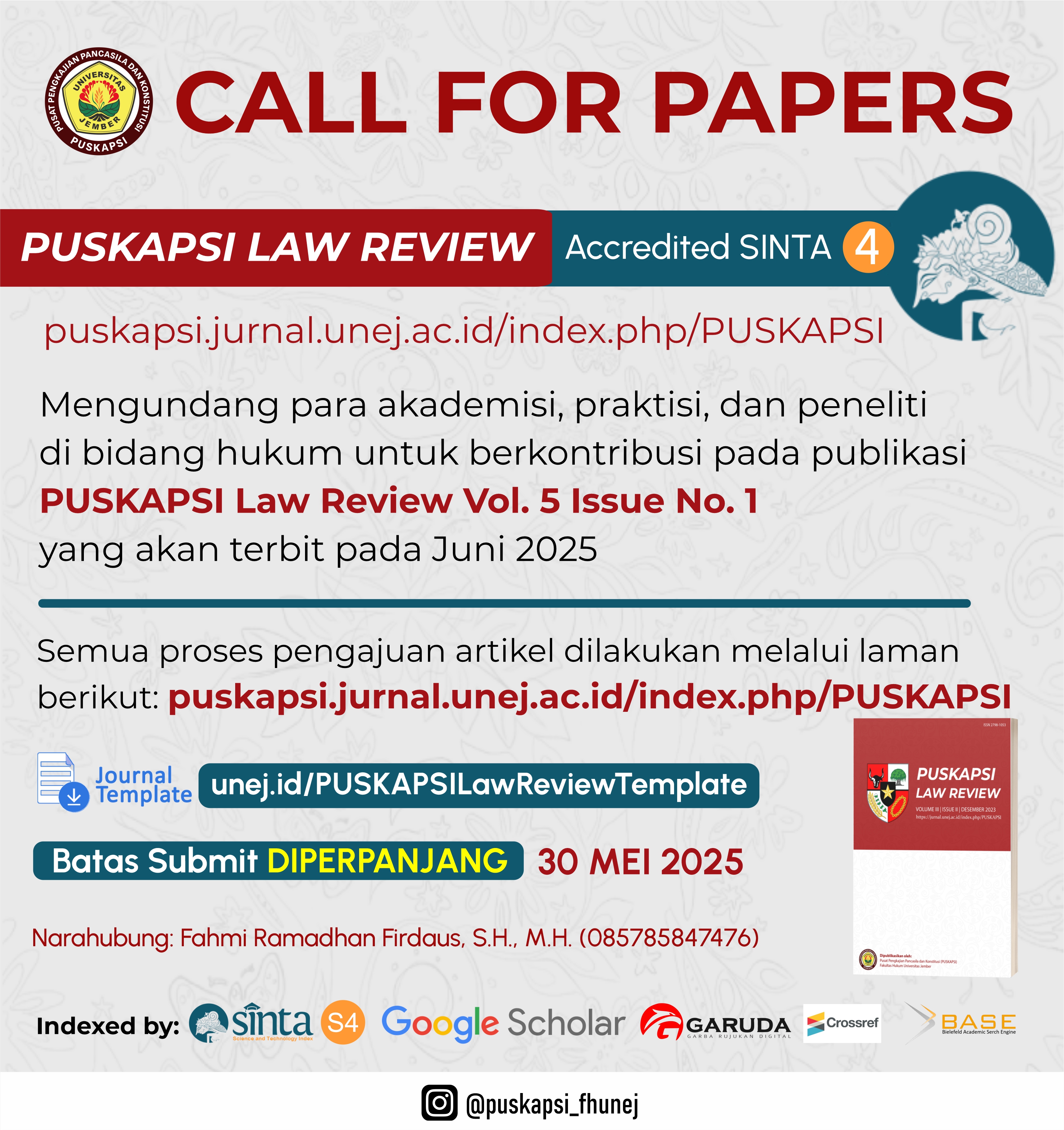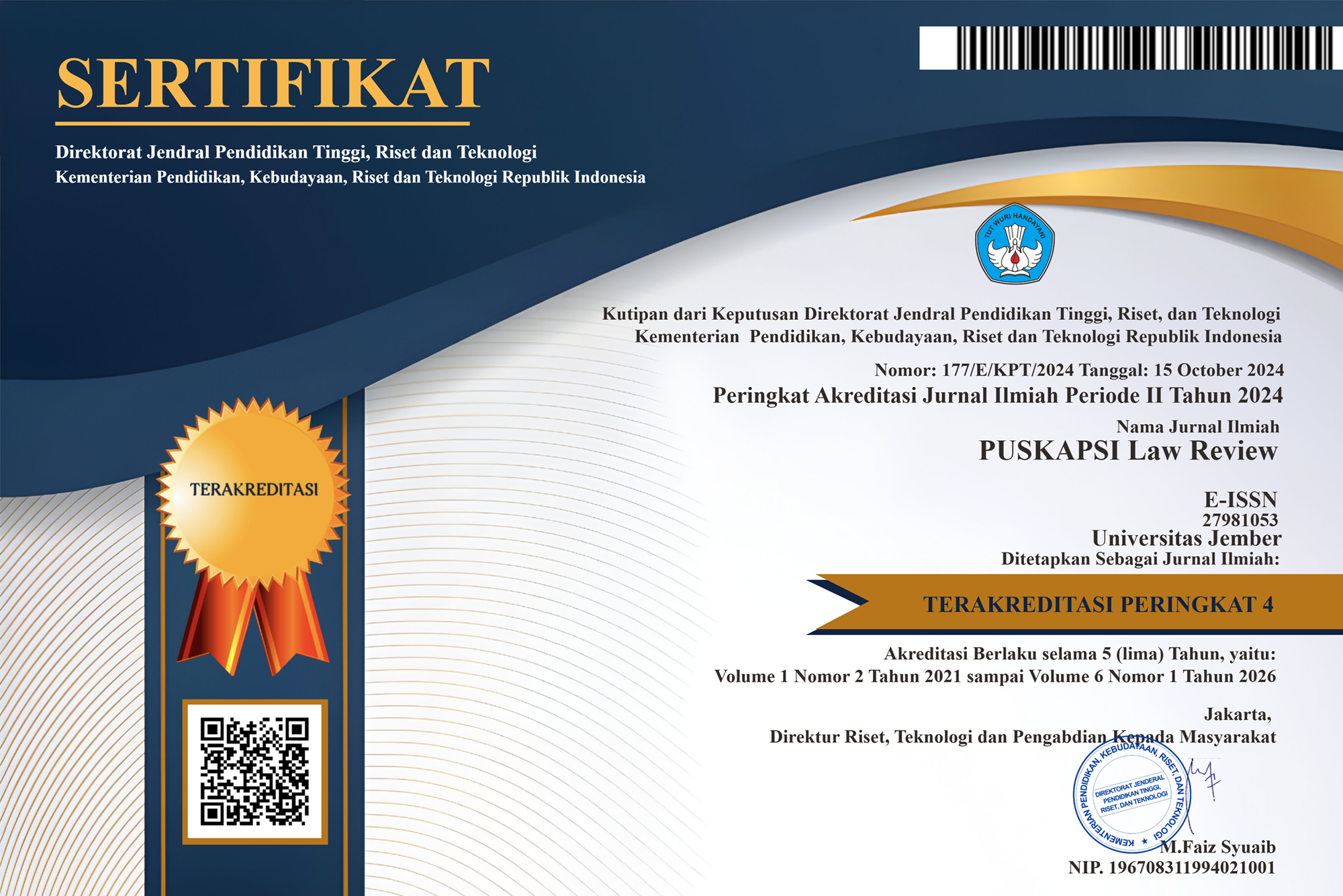
Author Guidelines
Tanggung Jawab Pengiriman Naskah
Dengan mengirimkan naskah, Anda mengonfirmasi bahwa Anda adalah penulis korespondensi, dan jurnal dapat menyimpan alamat email Anda untuk komunikasi terkait naskah yang diajukan. Dalam formulir pengajuan, pastikan detail pribadi Anda telah diisi dengan benar, karena informasi tersebut akan ditampilkan di halaman publikasi setelah naskah diterima.
Format dan Gaya Penulisan
Penulis diundang untuk mengikuti pedoman teknis dan format jurnal yang dapat diunduh di sini. Gaya sitasi yang digunakan adalah Canadian Guide to Uniform Legal Citation (McGill Guide), yang dapat diakses melalui Zotero.
Pedoman Penulisan Artikel
- Naskah harus mencakup minimal 30 catatan kaki, di mana 80%-nya berasal dari artikel jurnal yang diterbitkan dalam 10 tahun terakhir, sementara 20% sisanya dapat berupa laporan penelitian, buku, atau publikasi relevan lainnya.
- Panjang naskah adalah antara 6.000-8.000 kata, termasuk tabel, gambar, referensi, catatan, abstrak, dan judul.
- Editor berhak menolak naskah yang tidak memenuhi kriteria panjang tersebut.
Proses Awal (Pre-Review)
Semua naskah yang dikirimkan akan melalui seleksi awal oleh Dewan Editorial untuk memastikan kesesuaian dengan pedoman jurnal, fokus, ruang lingkup, dan kualitas akademik.
Pemeriksaan Plagiarisme
- PUSKAPSI menerapkan praktik internasional untuk mencegah plagiarisme dengan menggunakan Turnitin.
- Tingkat kesamaan maksimum yang diperbolehkan adalah 30%. Jika ditemukan plagiarisme, naskah akan ditolak.
- Tiga indikator utama plagiarisme:
- Mengulang konten tanpa sitasi.
- Menyalin sebagian besar karya orang lain tanpa pengakuan.
- Menggunakan ide, kata, atau frasa tanpa sitasi, meskipun dengan parafrase.
Review Naskah (Desk Review dan Peer Review)
- Desk Review:
- Naskah yang memenuhi kriteria akan maju ke tahap desk review.
- Dewan Editorial akan memberikan umpan balik untuk membantu penulis mematuhi standar jurnal.
- Peer Review:
- Proses ini bersifat blind review oleh dua reviewer ahli.
- Reviewer menilai orisinalitas, kejelasan presentasi, dan kontribusi keilmuan.
- Keputusan reviewer meliputi: diterima, revisi minor, revisi mayor, atau ditolak.
Revisi dan Keputusan Akhir
- Untuk revisi mayor, waktu yang diberikan adalah tiga minggu; revisi minor satu minggu.
- Manuskrip yang tidak memenuhi revisi yang diminta dapat ditolak pada tahap ini.
Proofreading dan Konfirmasi Publikasi
- Manuskrip yang diterima akan melalui proses proofreading untuk menjaga kualitas linguistik.
- Versi akhir akan dikirimkan ke penulis untuk memastikan tidak ada kesalahan tipografi sebelum publikasi.
Pemberitahuan Hak Cipta
- Hak cipta artikel akan dialihkan ke PUSKAPSI setelah diterima untuk publikasi.
- Penulis masih memiliki hak untuk menduplikasi, mengunduh, dan mendistribusikan materi dengan mencantumkan sumber.
Deklarasi Konflik Kepentingan
Setelah naskah diterima, penulis wajib melampirkan pernyataan bahwa tidak ada konflik kepentingan.
Penutup
Semua tahapan ini bertujuan untuk memastikan bahwa publikasi di PUSKAPSI Law Review mencerminkan standar akademik dan etika tertinggi.








.svg_.png)





